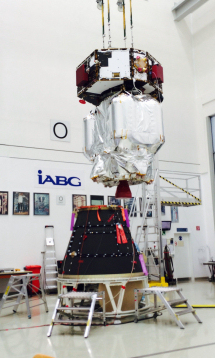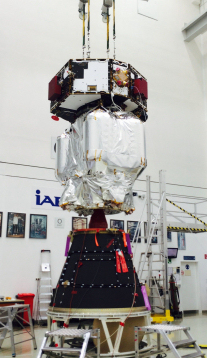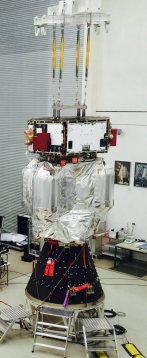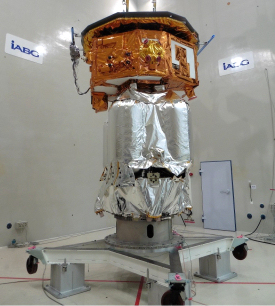LISA Pathfinder prepares for the Vega launcher
17 July 2015
LISA Pathfinder continues to make steady progress in preparation for launch later this year. The most recent tests have focussed on preparing for launch on a Vega rocket.LISA Pathfinder will be launched from Europe's spaceport in French Guiana on Vega flight VV06 later this year. For launch, the spacecraft will be secured to the Vega launcher by a launch vehicle adapter (LVA).
At the IABG test centre in Ottobrunn, Germany, tests have been carried out with the LISA Pathfinder launch composite – the science and propulsion modules – and the LVA to verify the mechanical and electrical interface between the spacecraft and the launcher.
The launch composite, measuring 3 m in height and 2 m in diameter, is mounted on the LVA with a clamp band interface. The clamp band is a metallic belt that holds two metal rings, one on the LISA Pathfinder launch composite and one on the LVA. The LVA in turn will be bolted on top of the launcher upper stage, called the AVUM – Attitude and Vernier Upper Module.
After launch, when the AVUM together with the LVA and the spacecraft reach the required low Earth orbit, with an apogee of about 1540 km, the spacecraft will be separated from the LVA. This is achieved by firing pyrotechnic devices to release the clamp band and compressed springs which provide a positive separation force.
 |
 |
 |
| The LISA Pathfinder launch composite and the LVA pictured at IABG. Credit: ESA – U. Ragnit | ||
The launch composite will then use the propulsion module to perform a series of manoeuvres to raise the orbit apogee. Just prior to entry in the operational orbit, a 500 000 km × 800 000 km Lissajous orbit around L1, the propulsion module will be separated from the science module, by firing the pyrotechnic devices of the clamp band which mated the two modules together since launch. This separation is to reduce the disturbance effect of the propulsion module and its residual propellant, enabling drag-free operation of the science module.
 |
| LISA Pathfinder launch composite in the acoustic noise test facility at IABG prior to acoustic noise tests. Credit: Airbus Defence and Space 2015 |
With the successful LVA tests completed, the LISA Pathfinder team at IABG prepared for the next Vega-related test. For this, they verified that the LISA Pathfinder launch composite can withstand the intense noise generated by the launcher rocket engines in the first few seconds after ignition. The tests were carried out in the IABG Acoustic Noise Test Facility, in early July 2015.
The acoustic noise tests were the last in a series of environmental tests that ensure the spacecraft can cope with the different conditions it will experience from launch to operation in space. The LISA Pathfinder team at IABG are now preparing for the final activities prior to shipping to the launch site.
About LISA Pathfinder
LISA Pathfinder is a European Space Agency mission to test the technology required to detect gravitational waves in the range of 0.1mHz to 1Hz. The mission will demonstrate critical technologies for future gravitational wave observatories, in a space environment. These technologies include: inertial sensing, drag-free attitude control, and interferometry with free-falling mirrors.
An industrial team led by the prime contractor, Airbus Defence and Space - Stevenage, is building LISA Pathfinder. Airbus Defence and Space – Friedrichshafen is the payload architect for the LISA Technology Package (LTP).




